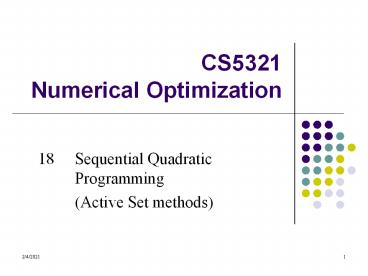CS5321 Numerical Optimization - PowerPoint PPT Presentation
Title:
CS5321 Numerical Optimization
Description:
CS5321 Numerical Optimization 18 Sequential Quadratic Programming (Active Set methods) Local SQP model The problem minxf (x) subject to c(x)=0 can be modeled as a ... – PowerPoint PPT presentation
Number of Views:265
Avg rating:3.0/5.0
Title: CS5321 Numerical Optimization
1
CS5321 Numerical Optimization
- 18 Sequential Quadratic Programming
- (Active Set methods)
2
Local SQP model
- The problem minxf (x) subject to c(x)0 can be
modeled as a quadratic programming at xxk - Assumptions
- A(x), the constraint Jacobian, has full row rank.
- ?xx2L(x,?) is positive definite on the tangent
space of constraints, that is, dT?xx2L(x,?)dgt0
for all d?0,Ad0.
3
Inequality constraints
- For
- The local quadratic model is
4
Theorem of active set methods
- Theorem 18.1 (Robinson 1974)
- If x is a local solution of the original problem
with some ?, and the pair (x, ?) satisfies the
KKT condition, the LICO condition, and the second
order sufficient conditions, then for (xk, ?k)
sufficiently close to (x, ?), then there is a
local quadratic model whose active set is the
same as that of the original problem.
5
Sequential QP method
- Choose an initial guess x0, ?0
- For k 1, 2, 3,
- Evaluate fk, ?fk, ?xx2Lk, ck, and ?ck(Ak)
- Solve the local quadratic programming
- Set xk1 xk pk
- How to choose the active set?
- How to solve 2(b)?
- Havent we solved that in chap 16? (Yes and No)
6
Algorithms
- Two types of algorithms to choose active set
- Inequality constrained QP (IQP) Solve QPs with
inequality constraints and take the local active
set as the optimal one. - Equality constrained QP (EQP) Select constraints
as the active set and solve equality constrained
QPs. - Basic algorithms to solve 2(b)
- Line search methods
- Trust region methods
- Nonlinear gradient projection
7
Solving SQP
- All techniques in chap 16 can be applied.
- But there are additional problems need be solved
- Linearized constraints may not be consistent
- Convergence guarantee (Hessian is not positive
def) - And some useful properties can be used
- Hessian can be updated by the quasi-Newton method
- Solutions can be used as an initial guess (warm
start) - The exact solution is not required.
8
Inconsistent linearizations
- Linearizing at xk1 gives
- The constraints cannot be enforced since they may
not exact or consistent. Use penalty function
9
Quasi-Newton approximations
- Recall for
- the update of Hessian is (BFGS, chap 6)
- If the updated Hessian Bk1 is not positive
definite - Condition fails.
- Define for ???(0,1)
10
BFGS for reduced-Hessian
- Let
- Need to solve
- Solve ? first to obtained an active set.
- Ignore term. Solve
- The reduced secant formula is
- Use BFGS on this equation.
11
1.Line search SQP method
- Set step length ?k such that the merit function
is sufficiently decreased? - One of the Wolfe condition (chap 3)
- D(?1, pk) is the directional derivative of ?1 in
pk. - (theorem 18.2 )
- Let ?k 1 and decrease it until the condition is
satisfied.
12
2.Trust region SQP method
- Problem modification
- Relax the constraints (rk0 in the original
algorithm) - Add trust region radius as a constraint
- There are smart ways to choose rk. For example,
13
3.Nonlinear gradient projection
- Let Bk be the s.p.d. approximation to ?2f (xk).
- Step direction is pkx-xk
- Combine with the line-search dir xk1xk?kpk.
- Choose ?k s.t. f (xk1) ? f (xk)??k?fkTpk.
- Combine with the trust region bounds pk???k.































